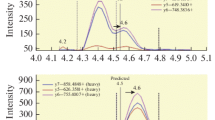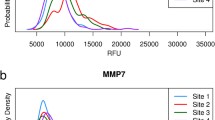Abstract
The purpose of the present work is to identify protein profiles that could be used to discover specific biomarkers in serum and discriminate lung cancer. Thirty serum samples from patients with lung cancer (15 cases of primary brochogenic carcinoma, 9 cases of metastasis lung cancer and 6 cases of lung cancer after chemotherapy) and twelve from healthy individuals were analyzed by SELDI (Surfaced Enhanced Laser Desorption/Ionization) technology. Anion-exchange columns were used to fractionate the sera with 6 designated pH washing solutions. Two types of protein chip arrays, IMAC-Cu and WCX2, were employed. Protein chips were examined in PBSII ProteinChip Reader (Ciphergen Biosystems Inc.) and the resulting profiles between cancer and normal were analyzed with Biomarker Wizard System. In total, 15 potential lung cancer biomarkers, of which 6 were up-regulated and 9 were down-regulated, were discovered in the serum samples from patients with lung cancer. 5 of 15 these biomarkers were able to be detected on both WCX2 and IMAC-Cu protein chips. The sensitivities provided by the individual markers range from 44.8% to 93.1% and the specificities were 85.0%–94.4%. Our results suggest that serum is a capable resource for detection of lung cancer with specific biomarkers. Moreover, protein chip array system was shown to be a useful tool for identification, as well as detection of disease biomarkers in sera.
Similar content being viewed by others
References
Smith, R. A., Mettlin, C. S., Davis, K. J. et al., American cancer society guidelines for the early detection of cancer, CA Cancer J. Clin., 2000, 50(1): 34–49.
Eggeling, F. V., Davies, H., Lomas, L. et al., Tissue-specific microdissection coupled with ProteinChip array technologies: Applications in cancer research, Biotechniques, 2000, 29(5): 1066–1070.
Bichsel, V. E., Liotta, L. A., Petricoin, E. F. et al., Cancer proteomics: From biomarker discovery to signal pathway profiling, Cancer J., 2001, 7(1): 69–78.
He, D., Xiao, X., SELDI protein chip technology and its applications in proteomics, Modern Instruments (in Chinese), 2002, 1: 1–4.
Eggeling, F. V., Junker, K., Fiedler, W. et al., Mass spectrometry meets chip technology: A new proteomic tool in cancer research? Electrophoresis, 2001, 22: 2898–2902.
Paweletz, C., Trock, B., Pennanen, M. et al., Proteomic patterns of nipple aspirate fluids obtained by SELDI-TOF: Potential for new biomarkers to aid in the diagnosis of breast cancer, Dis. Marker, 2001, 17(4): 301–307.
Vlahou, A., Schellhammer, P. F., Mendrinos, S. et al., Development of a novel proteomic approach for the detection of transitional cell carcinoma of the bladder in urine, American Journal of Pathology, 2001, 158(4): 1491–1502.
Petricoin, E. F., Ardekani, A. M., Hitt, B. A. et al., Use of proteomic patterns in serum to identify ovarian cancer, The Lancet, 2002, 359: 572–577.
Li Peiwen, Diagnosis and Treatment of Lung Cancer (in Chinese), Beijing: Traditional Chinese Medicine Press of China, 2001, Chapter 2.
Author information
Authors and Affiliations
Corresponding author
Rights and permissions
About this article
Cite this article
Xiao, X., Wei, X. & He, D. Proteomic approaches to biomarker discovery in lung cancers by SELDI technology. Sci. China Ser. C.-Life Sci. 46, 531–537 (2003). https://doi.org/10.1360/02yc0208
Received:
Issue Date:
DOI: https://doi.org/10.1360/02yc0208




